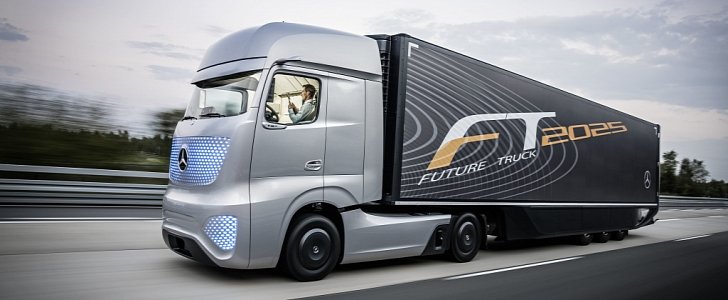As hard as it may seem to believe, long-distance shipping is still heavily reliant on road transport, and those large diesel trucks are responsible for releasing gigantic quantities of CO2 and NOx into the atmosphere.
But they need their big engines because they're moving around tons of goods, not to mention their own significant weight. Electric motors have shown they are just as good at dealing with heavy vehicles due to their abundance of torque and low-rev grunt, but using them in trucks presents the same problem as for the passenger cars: they can only provide a relatively short maximum range.
You might say that a truck's size provides enough space for installing much larger battery packs, but given the current level of battery technology, there is this fine balance that needs to be found between the weight of the battery pack and the power it provides. It all comes down to density (mass divided by volume), and right now there's nothing that could make electric long-haul trucking feasible.
Well, depends on who you ask. Charged EVs reports that a Swiss firm called Furrer+Frey that specializes in rail transport services has come up with a very simple, low-tech solution that could be virtually instantly available: tractor swapping. The plan isn't exactly new - a few years ago, the idea of making car batteries compatible across all brands so they could be easily swapped circulated for a while, but it eventually died out. But that was because a car isn't made out of two parts, and extracting a battery pack isn't as easy as with your TV remote control.
For trucks, though, it would make a lot more sense. Since the important part of the semi isn't really the tractor, but the trailer filled with goods, the former could be used just like they used to with horses: leave the tired one to rest and get a new set to continue the journey almost immediately.
The only real drawback to this solution is that the shipping companies would have to own multiple tractors scattered along their usual routes, and given the price of electric vehicles, they probably wouldn't be cheap. Also, these swapping places would have to be equipped with charging stations, but Furrer+Frey has that covered. The company offers an overhead high-power charging system that supports power levels of up to 650 kW.
But to make this profitable for shipping companies, a very carefully planned schedule system would have to be put in place. Even though it would be controlled by a computer, it could still make things a lot more complicated for everyone involved, with one minor hiccup requiring thousands of recalculations. In fact, this would work best with autonomous vehicles, when traffic flow would stop being such a big mystery.
You might say that a truck's size provides enough space for installing much larger battery packs, but given the current level of battery technology, there is this fine balance that needs to be found between the weight of the battery pack and the power it provides. It all comes down to density (mass divided by volume), and right now there's nothing that could make electric long-haul trucking feasible.
Well, depends on who you ask. Charged EVs reports that a Swiss firm called Furrer+Frey that specializes in rail transport services has come up with a very simple, low-tech solution that could be virtually instantly available: tractor swapping. The plan isn't exactly new - a few years ago, the idea of making car batteries compatible across all brands so they could be easily swapped circulated for a while, but it eventually died out. But that was because a car isn't made out of two parts, and extracting a battery pack isn't as easy as with your TV remote control.
For trucks, though, it would make a lot more sense. Since the important part of the semi isn't really the tractor, but the trailer filled with goods, the former could be used just like they used to with horses: leave the tired one to rest and get a new set to continue the journey almost immediately.
The only real drawback to this solution is that the shipping companies would have to own multiple tractors scattered along their usual routes, and given the price of electric vehicles, they probably wouldn't be cheap. Also, these swapping places would have to be equipped with charging stations, but Furrer+Frey has that covered. The company offers an overhead high-power charging system that supports power levels of up to 650 kW.
But to make this profitable for shipping companies, a very carefully planned schedule system would have to be put in place. Even though it would be controlled by a computer, it could still make things a lot more complicated for everyone involved, with one minor hiccup requiring thousands of recalculations. In fact, this would work best with autonomous vehicles, when traffic flow would stop being such a big mystery.

